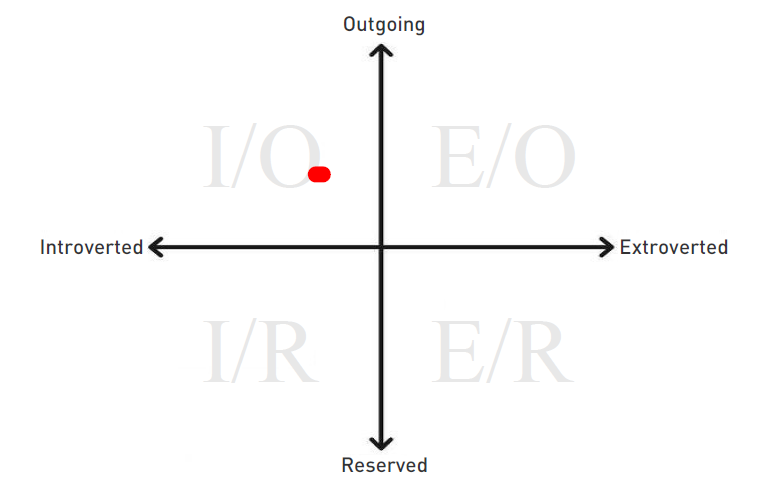
Are You an Outgoing Introvert? Why Introversion Matters in the Virtual Workplace!
Introversion/Extroversion
By NeuroColor Staff
You’re talkative, comfortable with people and…an introvert? You’re not alone. Even if this isn’t you, keep reading. The level of introversion on your team likely still affects your work and productivity, especially in remote work. In our recent study, 18% of people were outgoing introverts. If you don’t know how many of your co-workers prefer introversion or extroversion, your team may not be working together as effectively as possible. Understanding this key aspect of personality can increase engagement and reduce turnover.
Are You a “Typical” Introvert or Extrovert?
Most older studies of introversion/extroversion make the mistake of lumping your communication style together with how you reenergize. They are not the same! So, why has this never been corrected? Well, there is a strong correlation between introversion and reserved, and between extroverted and outgoing. Around 80% of people fit the traditional model. However, when you separate your introversion/extroversion preference (or “energy source”) from whether you are more outgoing or more reserved (your “communication style”), we find that 22% don’t meet the stereotypical definition of the outgoing extrovert or reserved introvert. In a world of 8 billion people, that means there are many of us roaming the earth who fall outside of these stereotypical norms.
22% of us don’t meet the stereotypical definition of the outgoing extrovert or reserved introvert.
A surprising percentage of people who are outgoing and talkative when with others also crave alone time after a day full of people. We’ve found that many team members don’t know this even after years of work with an outgoing introvert. Others may seem to be obvious introverts. They listen more than they talk, and you don’t always know what they’re thinking. But these reserved extroverts are energized by people and a hubbub around them. Their leaders may never know what these reserved extroverts need to feel engaged – until they quietly leave the team in search of more people contact. This, too, is a surprise to many co-workers.
Introversion and Virtual Work
Your preference for introversion or extroversion affects how you work best. It’s also an aspect of you that can be much harder to identify over Zoom, MS Teams, or other online platforms. Virtual isn’t necessarily conducive to getting to know each other at the same level as in-person work. If you are an outgoing introvert who readily chimes in with your thoughts and opinions during team video calls, your “think out loud” co-workers may have no idea that your best ideas often come when you have time to mull over a particular challenge or opportunity in advance. Or, that you are comfortable discussing topics as they come up but may also want to revisit the issue after you’ve had time to consider the idea or decision on your own.
And, what if it’s not just you? If you unknowingly have a high percentage of introverts on your team but don’t do enough planning before your online meetings, your meetings may drag out as you and your colleagues – who also think better on their own – try to process your thoughts while everyone is talking. Meeting efficiency suffers, and so do results.
Leverage Your Introversion
If you are an introvert, think about some of the most productive meetings you’ve attended. What made those meetings work well for you? And if you aren’t an introvert, learning about what works for your colleagues can improve team productivity.
Amazon famously employs a strategy that can work particularly well for introverts. Meetings start with a 6-page memo in a narrative format that the team reads silently together. Reading the memo may take a full 30 minutes, and founder Jeff Bezos admits that this creates “the weirdest meeting culture you [will] ever encounter.”1
Even if you don’t want to write a 6-page memo, there are simple steps you can take to leverage the introversion on your team and operate at your collective best. If you are more introverted, consider the following. (And, if you aren’t an introvert, try some of these techniques anyway as they can help bring out the best in everyone and may help stretch your thinking as well.)
- Request an agenda. Ask for an agenda or talking points to be shared in advance of the meeting. As you read through the document before the meeting, jot down your questions or concerns so you’re prepared to raise them when you get together.
- Follow-up email. If you need more time to reflect on a topic, let others know that you want to organize your thoughts and may circle back with a follow-up email.
- Use the chat function. If you prefer to let others talk first as you think through a topic more, add your thoughts via chat box. This allows you to edit your comment before posting, and contribute without having to time your comment to avoid cutting someone off.
- Pause to write down ideas. Regardless of whether you are leading the meeting, consider asking, “could we stop for 60 seconds and write down our thoughts?” Not only does this give you time to process your thoughts, but the short reflection period is also likely to benefit others on the team as well. Have the group go over the individual questions or ideas that participants write down – to make sure that all good ideas surface and that everyone’s concerns are addressed.
Each of us is unique, so find strategies that work for you and, most importantly, use them consistently.
Be Open About Your Meeting Preferences + Get to Know Your Team
Let your teammates know how you work best and find out how they do their best thinking. Many team members don’t know or understand each other as well as they think. Time and time again, we have seen how this creates a blind spot and liability for everyone. Specifically consider communication style and energy source.
- Communication Style. You probably already have a sense of whether your co-workers are more outgoing or reserved, but remember that your opinion of their communication style could depend on the topic being discussed, their experience level or their specific role on the team.
- Energy Source. You may be more in the dark about their introversion/extroversion preference and what keeps them energized and engaged. So, find out! This could be accomplished in a casual discussion. Or consider taking a quick poll. Ask team members whether they prefer to think things over or decide in the moment.
Do You Have Team Members You’ve Never Met in Person?
With the mid-pandemic abrupt switch to virtual work, most organizations scrambled to adapt systems and establish new team norms for collaborating online. It can be much harder to see team member’s work style preferences when you’re not physically together. But, without the ability to fully read body language or easy opportunities for impromptu one-to-one conversations, virtual work makes knowing each other even more important.
If you have team members that you haven’t seen face-to-face in months, or perhaps new team members you’ve never met in person, it’s time for a reset to optimize how you work together. Discuss their introversion/extroversion preference. Don’t assume or put them in a stereotypical box because of how you see their communication style. Go straight to the source and ask. (The graphic we use to illustrate energy source and communication style is included here.)

Conclusion
Taking time to examine how you work both individually and as a team can shortcut misunderstandings and increase effectiveness. Even small changes in how your team interacts can have a profound impact for you and your co-workers. Together, you can implement meeting strategies that leverage introversion and extroversion, and play to everyone’s strengths!
1 https://www.businessinsider.com/bezos-admits-amazon-has-the-weirdest-meeting-culture-2018-4
